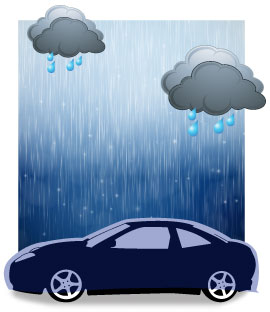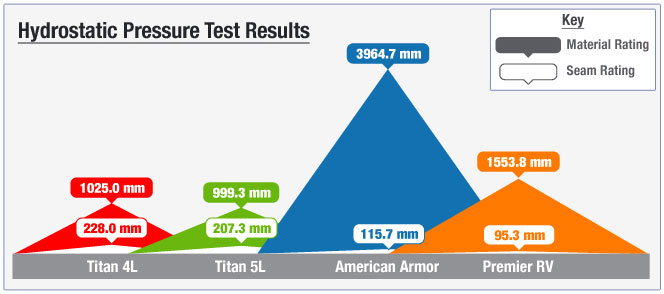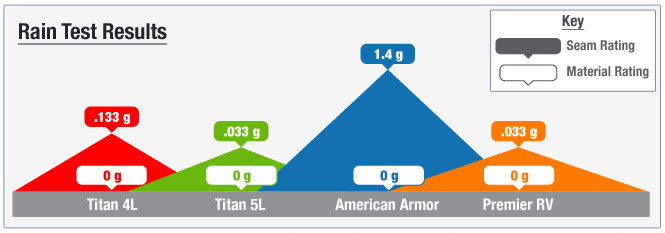
Waterproof Test

From carving the Grand Canyon to the destruction of cities and the erosion of shorelines, there is no force in nature quite as insidious as water. It’s not just violent storms or flooding, either. Despite man’s best efforts, water needs little more than movement and time to wear down and destroy nearly any conceivable material.
The damage that water can wreak on personal property is staggering, to the tune of billions of dollars paid out in water-related insurance claims every year. After suffering even a moderate leak, a homeowner can potentially face tens of thousands of dollars in damage. As if that weren’t enough, there’s an entirely new set of concerns after the water has been abated in the form of mold, mildew, and structural damage.
The same concerns apply to your car. Car covers are not totally immune to the threat of water - nothing is - but by selecting the right one, you’ll have the peace of mind that your investment is protected against water damage to the frame, finish, and interior.
At EmpireCovers, we pride ourselves in offering only the absolute highest-quality products available. Our EmpireCovers Research & Development Team conducts rigorous testing of our products before entering into commercial production. In this case, we devised a Hydrostatic Pressure Test that allows us to quantify the water-resistance (i.e. the degree to which a cover resists penetration by water) and water repellency (i.e. the degree to which a cover resists wetting).
Methodology
For this test, we investigated the water-resistance and repellency of four different covers: Titan 4-Layer Series, Titan 5-Layer Series, American Armor, and Premier RV. Our test method measured the covers’ resistance to the penetration of water under hydrostatic pressure, i.e. the amount of force distributed over an area by water. It’s important to note that a cover’s water resistance depends on the repellency of the fibers and yarns that comprise it, the way the fabric is constructed, and whether it’s treated with any finishes.
Our Research & Development Team cut 200mm square samples of each of the four covers, stretching them with clamps just until taut. They then subjected each side of the material to a stream of room-temperature water using a Hydrostatic Head Tester. The pressure of the water was increased at a constant rate for each specimen until water droplets appeared in three different places. The pressure at that precise moment was then recorded.
This test was conducted not only on the material itself but also at the seams of each of the various covers, which represent potential points of leakage due to the nature of stitching two pieces of fabric together.
Additionally, all samples were subjected to a Spray Test which gauged how “wet” the specimen had become after being exposed to water, as well as a Rain Test, in which a gallon of water was poured onto each specimen from 24” above it over a period of two minutes.
The goal of these tests was not to compare the car covers to a real-life situation, but rather to determine a baseline that can be used to compare each cover’s water-resistance and repellency properties.
Test Results
Among all fabrics tested for water resistance using the Hydrostatic Pressure Test, all performed to a minimum standard of at least “good,” with one performing “very good” and one, “excellent.” The table below demonstrates the average amount of water pressure necessary to cause three leaks in each fabric in three samples of each fabric.

The American Armor cover clearly provided the highest resistance to pressure at nearly 4,000 mm. However, the Titan 4L demonstrated the strongest water-resistance along its seams, nearly doubling the seam water-resistance of the American Armor.
The next table indicates the results of the Spray Test, again performed on the car cover material itself and the seams. This test measures the repellency of each respective fabric. The results are given on a scale of 0-100, where

For this test, both the Titan 4-Layer and the Premier RV performed “excellent,” while Titan 5-Layer and American Armor performed “very good” and “good,” respectively.
Lastly, the Rain Test - another measurement of water-resistance - demonstrates how each cover performed when subjected to more real-world conditions. Again in this case, both the fabric and the seams were tested. The numbers represent water penetration in grams:

Summary
In summary, car owners looking to protect their car would certainly be interested in knowing how each of their options stacks up in terms of water damage. What EmpireCovers’ scientific tests prove is that our covers are made to provide a high degree of both water-resistance and water repellency, regardless of which one you choose.
If shopping for a car cover, EmpireCovers provides a host of options across many different price ranges, each with their own strengths. Whichever is right for your car, it will protect your investment for years to come.
Learn more about how our covers protect against other harmful elements.
